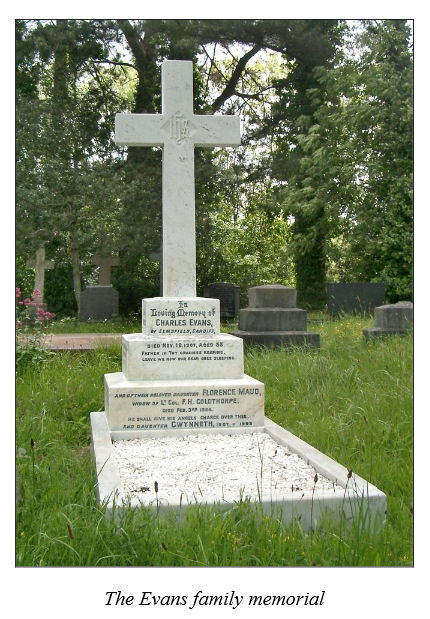Charles Evans
From New Zealand to the Friends, via Salisbury!
A lot of people take an interest in cemeteries as an aid to researching their family history and the assistance of the Friends is often sought. Sometimes this contact develops into a long and fruitful two-way exchange of information. One such exchange has been with Patricia Evans, who lives in Salisbury, Hampshire. We are very grateful to Mrs Evans, who has become a member of the Friends, for allowing us access to some of her family history memoirs in order to write this article.
Her husband's grandfather, Charles Evans, was buried in 1907 in Section L of Cathays Cemetery, coincidentally, the area that has benefited most from vegetation clearance by the Friends. Five other members of the family joined him later, including Patricia's father-in-law. No doubt her mother-in-law, Mary, would have joined them had she not emigrated to New Zealand -at the age of 92 -and, as she herself put it, "thought it better to be buried in their friendly soil". But it was Mary who had collected much of the family history information: not just the basic names, dates and places, but also a narrative, packed with anecdotes, that provide a veritable social history. Patricia's late husband did the marathon job of collating everything into a book format that runs into several chapters.

While we have only been privy to extracts from this, we can see that the Evans family has been traced back into the 17th century. But perhaps the most pertinent period of the family history is the era of Patricia's grandfather, Charles: the second half of the 19thcentury. Charles married the daughter of Dr Henry Paine who, as Medical Officer of Health, battled cholera & smallpox epidemics and the squalid conditions of the "Irish Quarter". He suffered himself, with the early deaths of his first three children, but should take great credit for his role in expediting the provision of the first sewerage system in Cardiff, which was instrumental in halving the death rate in the course of about 10 years. Dr Paine's grave is close to that of the Evans family.
Charles' elder sister, Blanche, married John Corbett, a name that will be familiar to those who know the Pwllypant area of Caerphilly where they lived. John's father had been Land Agent to the 2nd Marquess of Bute and managed the Bute Welsh Estate for 20 years after his death in 1848, until the 3rd Marquess came of age. John Corbett was to become solicitor to the 3rd Marquess and would have been involved in the exciting changes to Cardiff Castle, Castell Coch and, to a lesser extent, Caerphilly Castle.
Charles' younger sister, Winifred, married Dr Charles Vachell, a Freeman of the City, whose grandfather had twice been Mayor of Cardiff. Again, this name and monument will be familiar to those who have had a hand in the clearance work in Section L of the Cemetery. Mary's family memoirs recall a visit to the Vachell's grand house and surgery opposite the New Theatre in 1912, where patients were greeted by a "Buttons".
Towards the end of the 19thcentury, Charles, by now with a family of four children, moved to Elmsfield, in Newport Road. This name will also be familiar to regular visitors to the Cemetery, as it crops up on headstones several times. Elmsfield was one of a number of grand Bute houses in Newport and the book refers to it as "... a spacious house with a large garden and stabling at the bottom. However, it was a spartan house; the water was often frozen in the bedroom ewers, although there was a bathroom, and the downstairs hand basin had no hot tap. Perhaps this cold upbringing accounted for Lionel's toughness: he never wore gloves and seldom an overcoat. In her widowhood, Florence kept spare beds aired by sleeping in them in turn."
In the foregoing quotation, Florence is Charles' wife and Lionel is the son, who was to become Patricia's father-in-law. Sadly, these Bute houses in Newport Road made way for some rather utilitarian office blocks 50 or 60 years ago, with but one thing to commend them -hot running water!
It is only possible here to take a small dip into this family history treasure trove, but it is perhaps fitting to conclude with the principal author's advice, which we should all heed. "I would say that I started these memoirs too late. I began writing in 1985 and still had some way to go when I emigrated to New Zealand [1987]. Since then, with much importuning from my children, I have done my best, with diminishing energy, to finish them from long range. I mention this in the hope it may encourage others to start their memoirs and family histories much earlier than I did, since the days when family history, stories and traditions were passed on by word of mouth during long walks to church are, alas, gone; and it is hard to talk above the television! Unless you preserve these memories, they will die with you."
See fcc newsletter 6 pp2-3